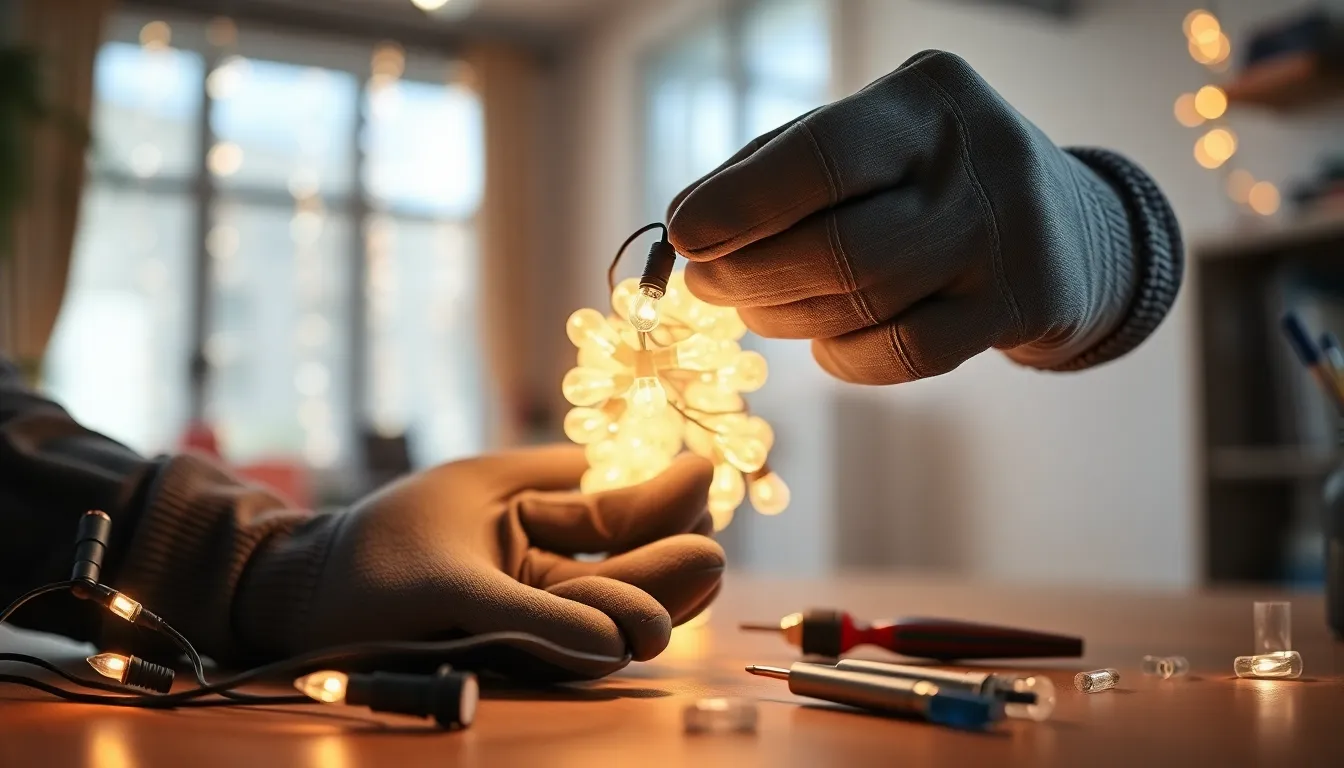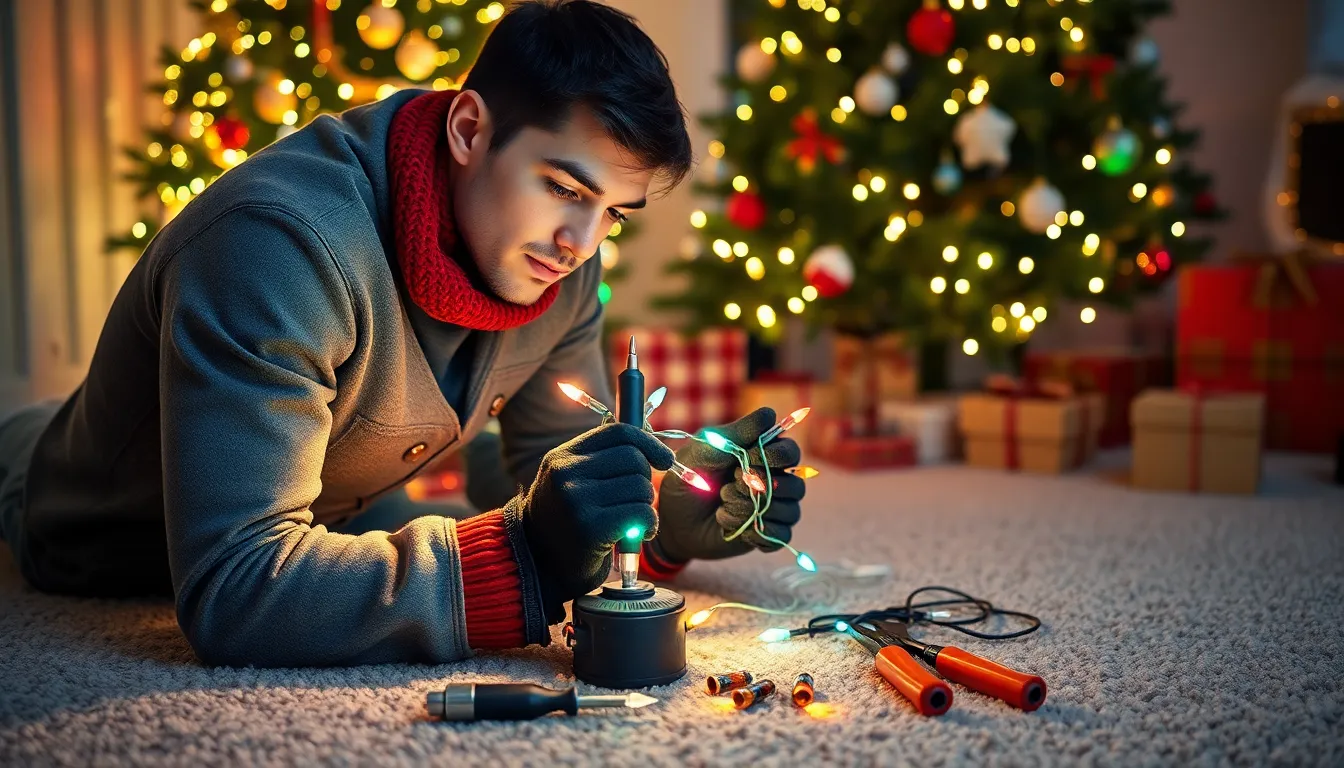As the holiday season approaches, twinkling lights become the stars of the show. But what happens when those festive strands flicker out like a party guest who’s had one too many eggnogs? Don’t let a blown fuse dim your holiday spirit! Changing a fuse in Christmas lights is easier than finding a parking spot at the mall in December.
Table of Contents
ToggleUnderstanding Christmas Light Fuses
Christmas light fuses play a crucial role in maintaining proper functionality during the holiday season. Understanding their types and importance helps ensure a festive atmosphere.
Types of Fuses Used in Christmas Lights
Christmas lights typically use two types of fuses: glass fuses and polymeric fuses. Glass fuses feature a visible filament and are common in older string lights. Polymeric fuses, found in newer designs, utilize a more durable casing and are often resettable. Identifying the type of fuse used in the lights aids in efficient replacement.
Importance of Replacing a Fuse
Replacing a blown fuse restores power to Christmas lights. A nonfunctional fuse can lead to partial or complete outages of light strings. Ensuring lights work properly enhances the visual appeal of decorations. Furthermore, timely fuse replacement prevents potential hazards, such as overheating or electrical issues. Keeping replacement fuses on hand simplifies the process and avoids disrupted holiday celebrations.
Preparing to Change the Fuse

Changing a fuse in Christmas lights involves specific steps to ensure safety and efficiency. Preparation is essential for a smooth process.
Safety Precautions
Safety stands as the top priority when handling electrical components. Unplugging the lights prevents electrical shocks. Wearing gloves protects hands from sharp edges. Inspecting cords before starting can reveal any wear or damage. Avoid wet areas to minimize risks associated with moisture. Keeping the work area clear of clutter ensures focus and reduces accidents.
Tools and Materials Needed
Gather essential tools and materials before beginning the fuse change. A screwdriver assists in opening the fuse holder. Needle-nose pliers make it easier to remove and install fuses. Replacement fuses must match the specifications of the original ones. Having a flashlight helps illuminate dark areas. Labels or markers can help identify different fuse types if multiple are present. Keeping all materials organized speeds up the process and ensures quick access.
Step-by-Step Guide to Changing a Fuse
Changing a fuse in Christmas lights involves a few straightforward steps. Each step ensures that the lights work properly and safely.
Step 1: Unplug the Lights
Unplugging the lights prevents electrical shocks and ensures safety during the process. Disconnecting from the power source reduces the likelihood of accidents. Make sure the power cord is completely disconnected from the outlet before proceeding.
Step 2: Locate the Fuse Compartment
Finding the fuse compartment comes next. Most Christmas lights have a fuse compartment located near the plug. Open the compartment by gently sliding or lifting the cover to access the fuses inside.
Step 3: Remove the Old Fuse
Removing the old fuse is straightforward. Use needle-nose pliers to grip the fuse securely and pull it straight out. Inspect the fuse for any visible damage, such as a broken filament, to confirm it needs replacement.
Step 4: Insert the New Fuse
Inserting the new fuse is simple with the right replacement. Match the new fuse’s specifications to the old fuse’s rating. Push the new fuse into the empty slot firmly until it clicks into place.
Step 5: Test the Lights
Testing the lights verifies that the replacement succeeded. Plug the lights back into the outlet and power them on. If the lights illuminate, the fuse replacement was successful, allowing your festive decorations to shine bright.
Common Issues and Troubleshooting
Identifying common issues with Christmas lights helps maintain a festive atmosphere. When a blown fuse occurs, it’s essential to consider whether replacing the entire set is necessary.
When to Replace the Entire Set
Consider replacing the entire set of Christmas lights if multiple fuses blow within a single season. Frequent fuse failures suggest potential problems with the overall wiring or design of the lights. Assessment of the age of the light set is crucial; older models often can’t handle modern electrical demands and may need replacing. Visible wear such as frayed wires or corroded connections also indicates a need for a new string of lights. If these issues appear, investing in a new set ensures safety and reliability during the holiday season.
Signs of a Deeper Electrical Issue
Some signs indicate a deeper electrical issue beyond just a blown fuse. If lights flicker consistently or fail to turn on even after replacing fuses, this points to wiring problems. Additionally, a burning smell or discoloration at plug points signals serious electrical hazards. Checking circuit breakers for frequent trips or blown fuses in the household system may reveal broader electrical concerns. When facing these symptoms, consulting a qualified electrician is crucial for safety and proper resolution.
Changing a fuse in Christmas lights is a straightforward task that can keep holiday spirits high. By following the proper steps and safety precautions, anyone can restore their festive decorations in no time. Understanding the types of fuses and having replacements on hand can make the process even smoother.
If issues persist after replacing a fuse, it’s crucial to assess the overall condition of the lights. Addressing potential electrical hazards early ensures a safe and joyful holiday season. With a little preparation and knowledge, holiday lights can shine brightly, creating a warm and inviting atmosphere for all to enjoy.




